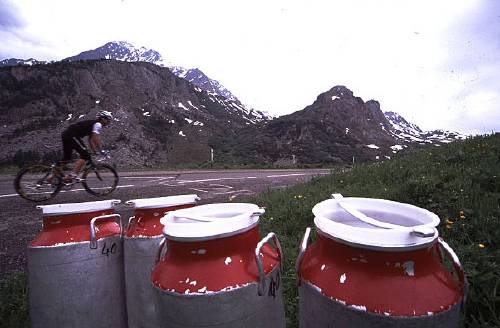 Mont Blanc – the highest in Europe |
If you’re looking for an awesome Alpine epic then the Tour du Mont Blanc could be perfect for you. Our route is an extended version of the permanent randonee, and takes in some 8 major cols, 9000 meters of climbing and covers 234 miles along the way. This ride is a serious challenge, and I recommend you slice it up over 4 days, at least.
Starting and finishing from Chamonix you completely encircle the highest peak in the Alps, and will have superb views as you pass through three countries on the ride, which should help ease the suffering on the climbs.
Stats
Distance – 234 miles
Duration – 3-4 days
Total climbing – 9000 metres+
Grade – tough
Bottom gear – 39 x 28/triple
Terrain – mostly well surfaced and hilly, though some of the back roads can be a little rough.
Traffic – there can be quite a lot of traffic on the section between Martigny and Aoste and the first part of the road towards Courmayeur, and also out of Cluses.
The route
Part way up the climb take the right turning on to the old road, which takes you over the Grand St Bernard.
Turn right and cross the Saisies to Flumet.
|
|
Itinerary
The official TDMB is a permanent 323 km randonee run by the CTC Chambery and does not take in the last part of the route that we have selected – it cuts from Flumet straight back to Chamonix. With our route I would suggest making a 4-day trip of things by over-nighting in Aoste, Bourg St Maurice and La Clusaz, although you could do it in three days if you’re feeling fit.
The (major) climbs
Coil des Montets 1461 meters
Col des Forclaz 1527 meters
Col du Grand St Bernard 2469 meters
Col du Petite St Bernard 2188 meters
Cornet de Roseland 1968 meters
Col des Saisies 1633 meters
Col des Aravis 1498 meters
Col de la Colombiere 1618 meters
Getting there
The best option for getting to) is via Geneva airport. Most international airlines serve the airport, including budget operator Easyjet. From the airport it’s an easy one-hour drive to Chamonix. Just about all-major car hire companies have desks at the airport, and rates are reasonable in Switzerland.
|
|
Accommodation
If you intend to make this a self-supported trip then I would suggest simply showing up in town and taking a stroll around. There is no shortage of lodging options here, though of course it can get busy at peak times and during French national holidays. Expect to pay around 25-60 Euros per room night here and elsewhere along the route.
For further information and bookings check out:
When to go
The best times to tackle this ride are between early June and late September, when the weather is at it’s best and the passes should be open. Even so it pays to check the listed web sites in advance as the weather could turn and block some of the higher passes at any time of the year.
Be sure to be prepared for everything weather-wise from searing heat to snow showers when riding in the high Alps.
Food and drink
 Take a few days to tackle this one |
Our ride is predominantly based around the Haute Savoie region, so local dishes figure high on most menus. Being so mountainous you can expect plenty of potatoes, meat and cheese in these dishes; taritiflette (potatoes baked in cheese and cream sauce), cheese fondues and raclette (self grilled potatoes, ham and cheese) are perhaps the most typical of local dishes, although you can get just about anything you desire food wise.
Chamonix is very ‘anglofied’, and as such has plenty of pizzerias, Chinese and even Mexican restaurants, while things are far more traditionally Italian in Aoste.
There are plenty of good local ales (especially the whisky beers) and the Savoie region produces some decent red wines (largely Gamay). While passing briefly into the Swiss Valais try and pick up a bottle of the local Valasian white wine, which is very good and hardly gets seen outside of the region.






